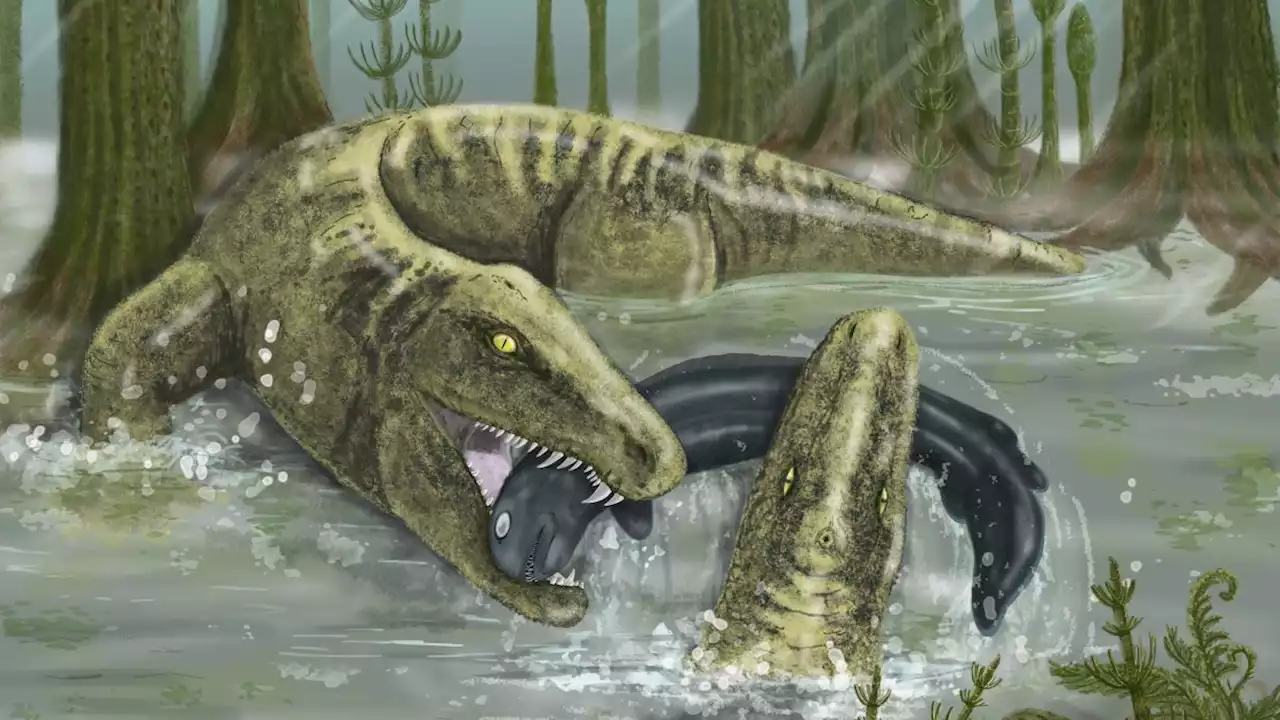Fangy Whatcheeria measured up to 6.5 feet (2 meters) long, and more than 300 million years ago, it was the apex predator in the sinkholes-turned-lakes of the American Midwest.
A fangy, 6-foot-long carnivore that haunted the lakes of what is now the American Midwest would have been a top predator in its freshwater ecosystem — a"T. rex of its time," according to scientists who studied the creature. And it grew up fast, new research finds.
"It would have made Whatcheeria the biggest thing in the lake: Go wherever you want, eat whoever you want," said Ben Otoo , a doctoral candidate at Chicago's Field Museum and the University of Chicago and one of the authors of a new study describing W. deltae published Monday in the journal Communications Biology .
That meant that Otoo and their colleagues had an opportunity to study how W. deltae grew. Early tetrapods like whatcheeriads were related to modern reptiles, amphibians and mammals but was in a different evolutionary lineage than the ancestor of those three groups. Modern-day birds and mammals tend to grow quickly in their youth and then stop growing, while reptiles tend to grow quickly at first and then continue growing, but more slowly.
"You have this animal that is racing to get to reproductive age to get to at least a decent size really quickly, because the best way to get yourself out of a predator's range of prey items is to get bigger," Otoo told Live Science.
Argentina Últimas Noticias, Argentina Titulares
Similar News:También puedes leer noticias similares a ésta que hemos recopilado de otras fuentes de noticias.
 Car of the Week: This Rare and Outrageous 1991 ‘Rambo Lambo’ Is Heading to AuctionMake way for the Rambo Lambo! One of the 328 examples built, it will be offered without reserve through RM Sotheby's on December 10.
Car of the Week: This Rare and Outrageous 1991 ‘Rambo Lambo’ Is Heading to AuctionMake way for the Rambo Lambo! One of the 328 examples built, it will be offered without reserve through RM Sotheby's on December 10.
Leer más »
 Scientists just revived an ancient virus that was frozen for 48,500 yearsScientists have managed to revive ancient viruses found within the Siberian permafrost, posing concerns about further defrosting.
Scientists just revived an ancient virus that was frozen for 48,500 yearsScientists have managed to revive ancient viruses found within the Siberian permafrost, posing concerns about further defrosting.
Leer más »
 How technology is revolutionising our understanding of ancient EgyptIn November 1922, Howard Carter opened the tomb of the boy king Tutankhamun. Now, a century on from the astonishing discovery, new scientific technology is bringing ancient Egypt into sharper focus
How technology is revolutionising our understanding of ancient EgyptIn November 1922, Howard Carter opened the tomb of the boy king Tutankhamun. Now, a century on from the astonishing discovery, new scientific technology is bringing ancient Egypt into sharper focus
Leer más »
 Ancient giant sea turtle with never-before-seen features found in Europe, scientists say | CNNPrehistoric giant marine turtles were once thought to have existed only in waters surrounding North America. With a newly discovered species found in Europe, scientists believe giant turtles may have been more common than originally thought.
Ancient giant sea turtle with never-before-seen features found in Europe, scientists say | CNNPrehistoric giant marine turtles were once thought to have existed only in waters surrounding North America. With a newly discovered species found in Europe, scientists believe giant turtles may have been more common than originally thought.
Leer más »
 Japan's Ancient Building Technique Joins Wood Without Glue or NailsBefore there were complex wood glues or screws, Japanese craftsmen used kanawa tsugi; a series of interlocking joints to connect wood for structures.
Japan's Ancient Building Technique Joins Wood Without Glue or NailsBefore there were complex wood glues or screws, Japanese craftsmen used kanawa tsugi; a series of interlocking joints to connect wood for structures.
Leer más »
 Ancient giant sea turtle with never-before-seen features found in Europe, scientists sayScientists have discovered a previously unknown species - the largest European sea turtle ever to be identified.
Ancient giant sea turtle with never-before-seen features found in Europe, scientists sayScientists have discovered a previously unknown species - the largest European sea turtle ever to be identified.
Leer más »
